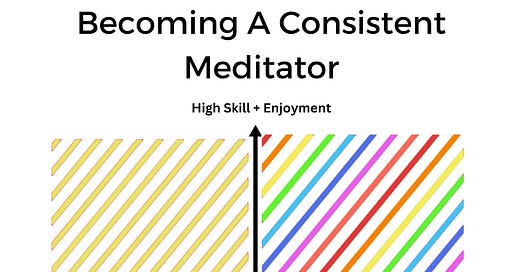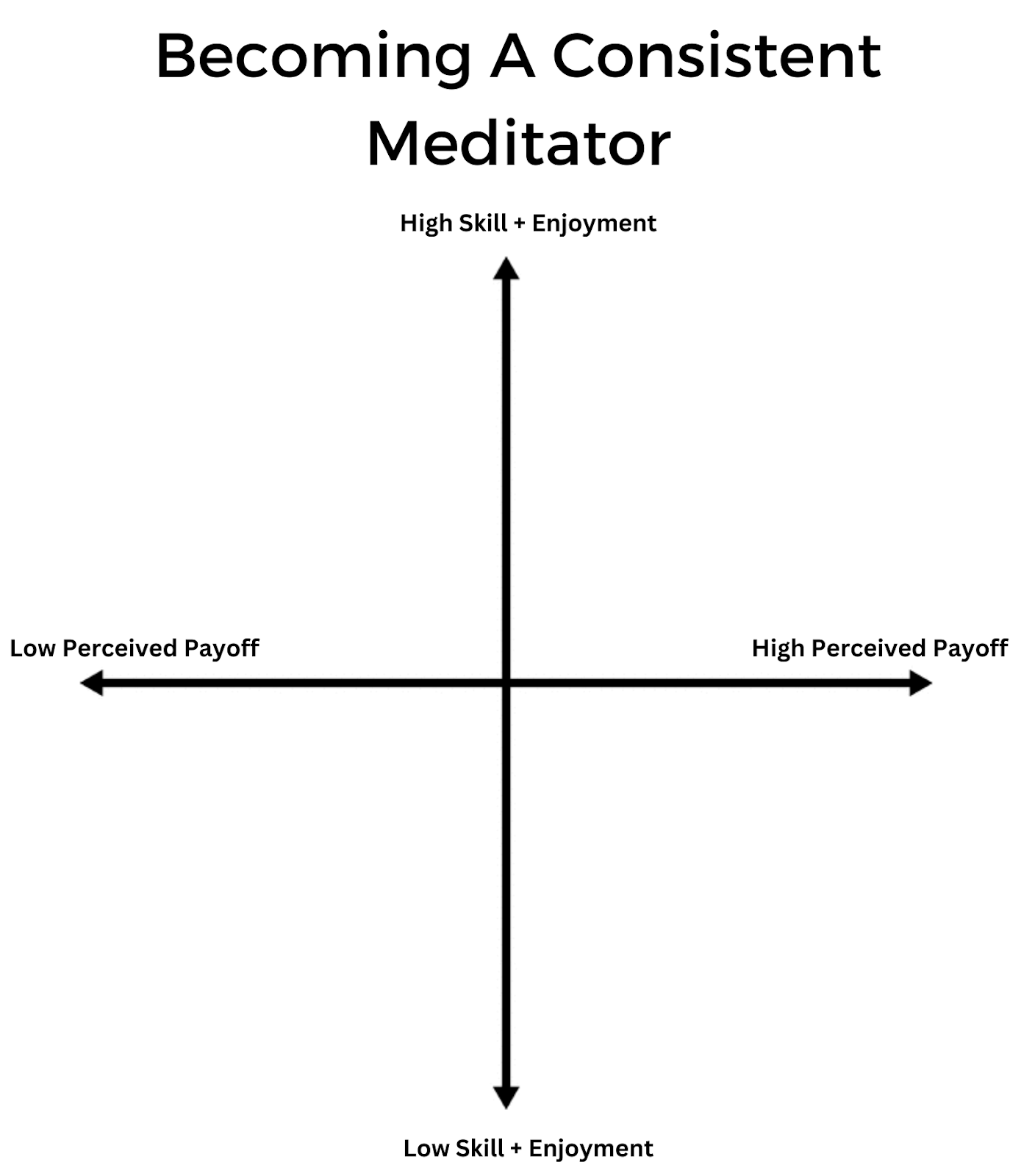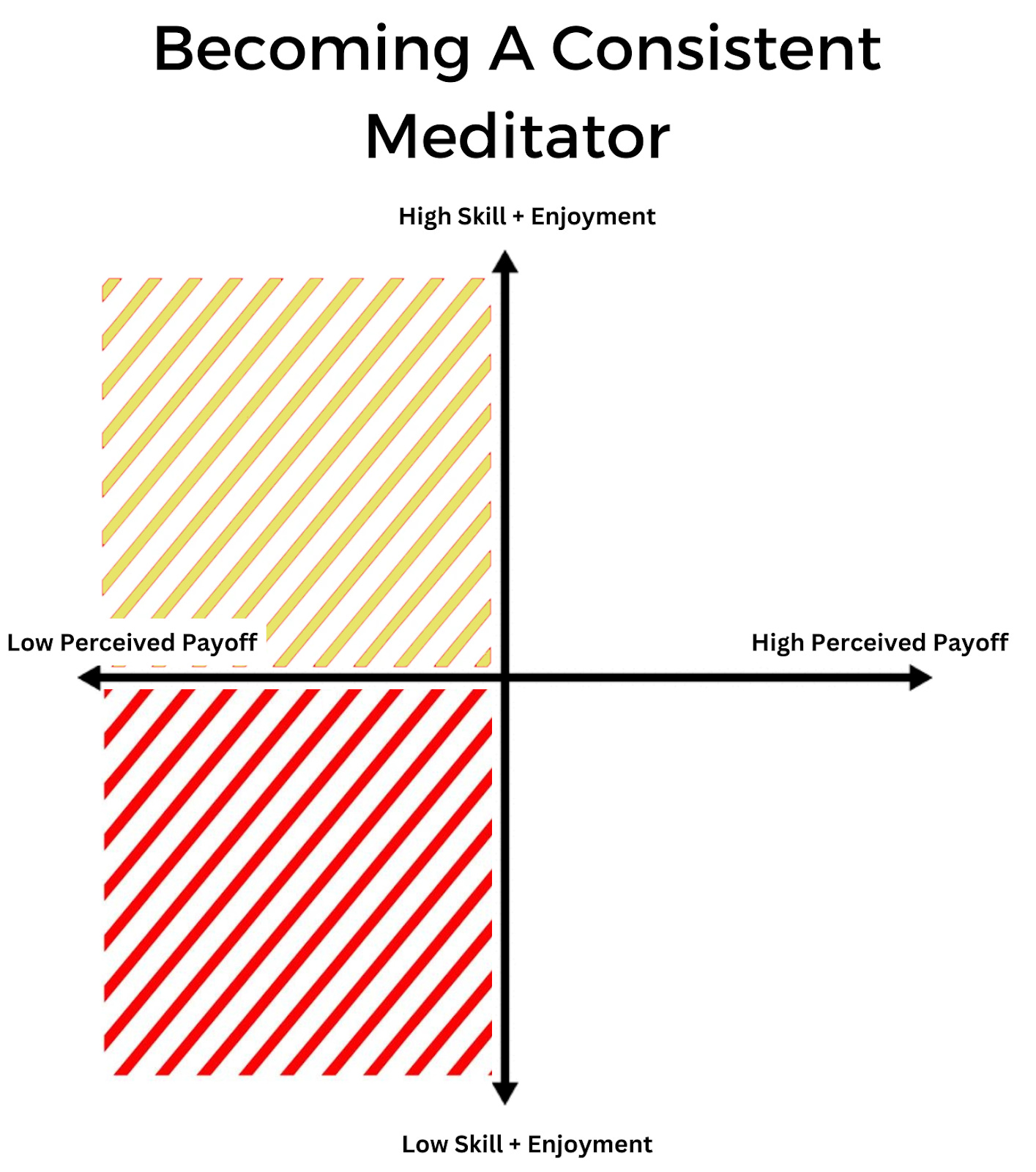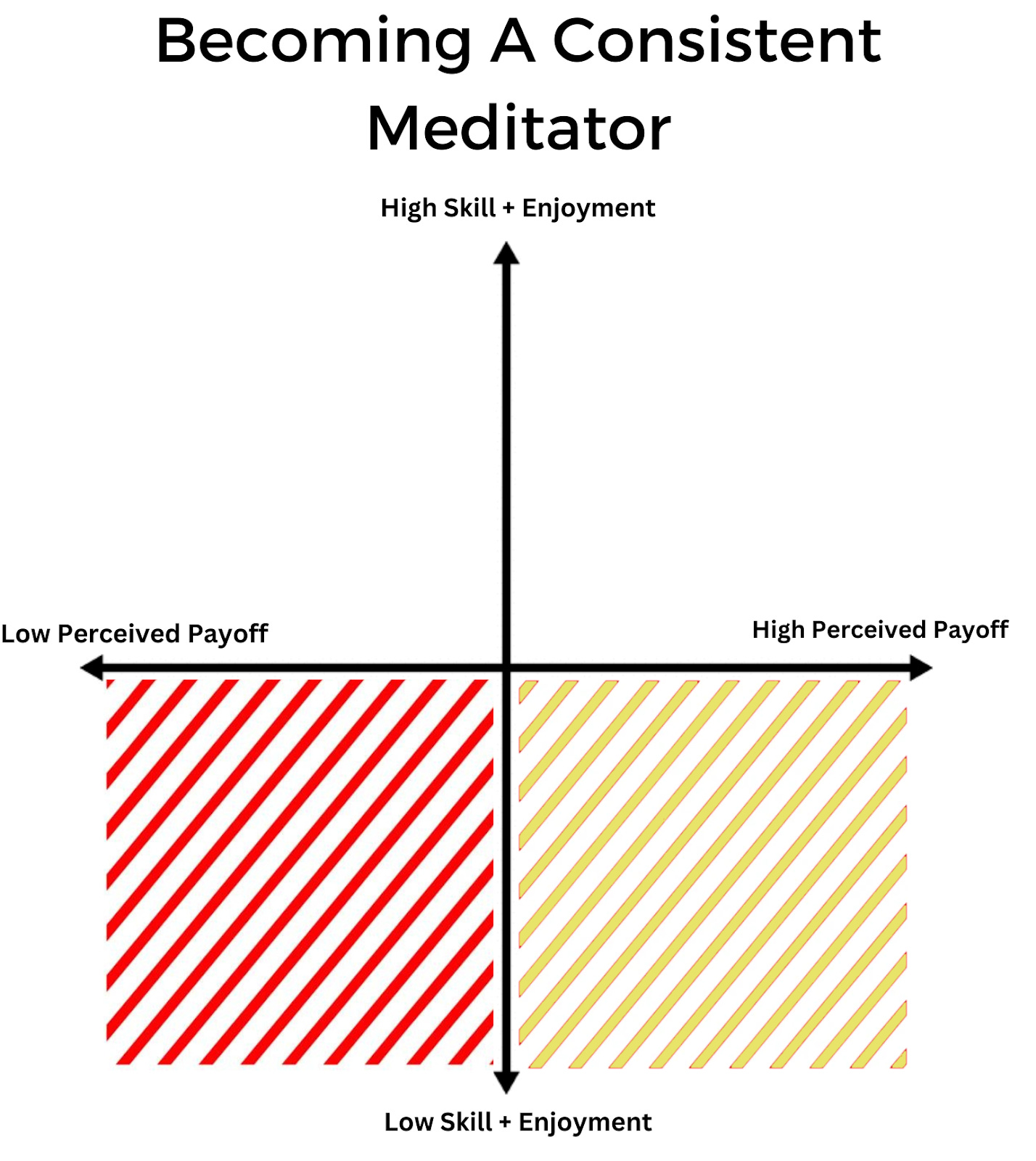If You Struggle To Meditate Or Stick With It Read This
A framework and practical tips to building a sustainable meditation practice
If you like my writing, feel free to click the ❤️ button on this post so more people can discover it on Substack 🙏
“How do you stick with meditation? I’ve tried and can’t see to make it a part of my life”
I’ve gotten this question 3 times in the past week from friends. I’m taking it as a sign that perhaps it’s time to share some public thoughts on this.
I documented the evolution of my 10 year meditation journey a few weeks ago. If you read it, you’ll see that life forced me to become a devoted meditator. Initially, this was by threatening me with the prospect of becoming a 25 year old guy with alopecia and no eyebrows. Then years later, my startup stress rollercoaster led to a mini panic attack which finally made it a non-negotiable everyday ritual.
For many people, this is how the shift inward works. You don’t actively choose it. It chooses you by shaking up your existing reality so intensely that you’re forced to throw your hands up and change.
Well how come some people have this and others don’t? It seems like there’s a lot of successful happy people that don’t need to eat dirt in life to the extent that they are redirected inward.
The Karmic interpretation of this is that eventual inward redirection is somewhat predetermined based on someone’s propensity and state evolution based on all lives leading up to this one A simple way to think about it is “soul maturity.” If you believe in this concept, which I do, it means I never really had a choice. I just was under the illusion that I chose to become a meditator.
As fascinating as this is to contemplate, I am not sure this is really helpful for people struggling to meditate.
What is Meditating Really Anyways?
I think a lot of people desire to meditate because they read somewhere that it was a good thing to do. They aren’t even really sure why they are doing it or where it can take you, but they know a lot of smart people do it and say it makes them happier.
I see meditation as just one entry point to the initial overarching goal of stilling or quieting the mind. So instead of being intent on developing a meditation practice, I think it might first be helpful to recognize that what you are trying to achieve is stillness of the mind.
There are many ways you can achieve a break from the incessant mind activity outside of meditation. These modalities include:
Sound (soundbaths, nervous system entrainment like NuCalm)
Breathwork (Othership)
Qigong and Tai-Chi (I learned Qigong here)
Walking in nature
Physical activity (surfing, running, or anything that gets you into a flow state)
Creative work (writing, art, design or anything that get you into a flow state)
So if you really struggle meditating, I recommend exploring these other activities to see if you find them more pleasurable. The goal is to first experience how wonderful the stillness of the mind is, then to develop an affinity for it. The affinity for stillness then blossoms into motivation which is required to deepen any practice.
The reason that the practice of meditation is such a valuable stillness practices is that it’s always accessible. It’s a lot easier to close your eyes and quiet your mind during the workday than to go surfing or even go do a NuCalm sound experience. Moreover, it is my experience as you become a skillful meditator, you can access greater depths of experience more reliably.
What do I mean by that? Well, when I got started I had no idea what was possible with meditation. I just wanted to be less stressed and keep my hair so I didn’t die bald and alone.
Now 10 years later, I see the quiet mind as my most valuable resource that I rely on constantly. It’s a place where I can drop in and get superior answers to any questions I have about life. It’s where spontaneous creativity and strokes of brilliance originate. It’s how I can change my state in any moment if life triggers me. And last and perhaps most importantly, it’s how I can examine my unconscious patterns that surface when I am disturbed by life’s events. These patterns were unconsciously the masters of my life experience for a long time and stand in the way of restoring our true nature which is embodying abundant love, prosperity, peace, and safety.
Mechanically, it’s important to note that once you learn how to quiet your mind, you can then start to engage in more active and direct stillness practices. . Nowadays, it’s not like I just sit there and focus on my breath to perform the activities above. With practice, you start to learn how to use the conscious mind to engage the stillness and bodily sensations to enhance your life. It kind of feels like a mysterious and wonderful dance with a divine, loving best friend that’s always there and always has your back. So when you desire to start meditating, it’s important to know that these potentialities wait for you if you keep going and there’s much more beyond simply feeling the sensations of your nostrils on the inbreath and outbreath.
If you want a great body and are just starting in your fitness journey, seeing a ripped cover model might motivate you to continue on for such an eventual result that may take years of training. Unfortunately, it’s not easy to see the eventual majesty of the inner world if you keep going and treat your practice like a life-long pursuit.
Maybe surfing, qigong or sound can reliably supply these additional features for others like providing higher intelligence to life’s questions because the place in which they emanate from is just the stillness. I’m not sure. But it seems to me that meditation is the most accessible and reliable access point to these greater depths of experience. That’s why I consider these other activities more like preambles or gateway drugs to developing a dedicated stillness practice like meditation that can be turned on at any moment until eventually it becomes your predominant state. Many call this witness consciousness and I described my experience with it here.
So How Do We Get There?
Last night in the stillness, a vision for this chart came into my awareness like an epiphany while doing an evening meditation. Meta, I know. But this is how purifying your consciousness works. When you work on removing everything blocking a more consistent and direct connection to a higher intelligence (pure consciousness), you receive a consistent stream of “ahas” and inspiration around whatever you direct your attention towards. It’s fucking awesome and one of the most profound discoveries of my life.
If you are struggling with meditation, my guess is that you either do not have a high perceived payoff of the activity or you simply haven’t done it enough to begin to develop more skill and enjoyment. Let’s not forget that it might be both!
Low Perceived Payoff
I think the more common problem most people have who complain about not sticking with meditation is more of a perceived payoff issue than a skill issue. This can be true even when someone thinks they have a high perceived payoff.
Low perceived payoff expresses itself by evaluating the practice of meditation as a tradeoff to the zillion other more active things you could be doing that the world and ego tells us will make us happy. If this sounds like you, you should not feel bad about it. We are conditioned to think this way by society and for years I struggled to sit down for 20 minutes when I could have been doing something else that seemed more productive.
I read this study on
's blog the other day which corroborates this:People were given the choice to sit quietly with their thoughts for 15 minutes or else self-administer painful electric shocks to themselves. 67 percent of men and 25 percent of women choose to shock themselves. (source).
What happens more often than not is that meditation and inward work is treated casually or something we “try to do when we can.” Bo Shao talks about this and his own experience in this phase of his journey very eloquently in this conversation on the Tim Ferriss show which I recently listened to thanks to Kwiri Yang.
Even if you do it everyday, it is viewed as a checklist item on your to do list vs. the top priority in our lives. Again, this was me for around 7 years.
So What Can We Do About This?
As I mentioned earlier, the shift away from this usually occurs when something dramatic happens in life or you feel depressed which leads you to understand that trying to control the outside world is not the answer to happiness. This is often the mechanism of action to push someone to pursue a meditation or stillness practice more seriously. It’s also why it's common for someone who doesn’t really have a lot of challenges in life often forgoes seriously pursuing the inward path towards unconditional joy and realization.
I’m not sure you can or should fabricate a negative catalyst to move the predominant focus inward. But what you can do is be honest with yourself about happiness. Is it objectively based on what’s happening out there or your reactions to it?
How is it possible that you and someone else can view the same exact thing and you are pissed and the other person feels nothing? Sitting with these questions should give you some clues that happiness is much less about what’s actually happening (content) and more about your perceptions of it (context).
If you truly and earnestly internalize this, then you must start to associate that stillness and meditation are time-tested pathways to begin to undo all the things causing your negative reactions to life. As Michael Singer describes, it’s a key part of feeling good all the time!
Does a 7 figure cash injection or perfect body really have the ability to make you feel good all the time?
Maybe for a bit, but it doesn’t persist. And sooner or later, you’re back into living from a place of conditionality where everything has to go your way in life to feel good. It doesn’t have to be like this. I know that might sound crazy, but there is another way and it’s inward.
So first you really need to get clear on this. Whatever you’re obsessing over out there, is not the answer. And as you do this, you will start to become open to the idea that whatever tradeoff math you are doing when you contemplate meditating, the answer becomes that prioritizing the inward practice always has the highest payoff of any activity.
Just F*ing Commit
Once you are open to this possibility, you need to commit to your inward experience being your #1 priority. Bo talks about how long he resisted this in the podcast which is very similar to my own experience.
I recommend treating the commitment period like a time bound experiment. Commit to meditation or a daily stillness practice for 3-4 months wholeheartedly. Doing something wholeheartedly means that you’re not just “doing the task” while continuing to think it’s not as valuable as everything else. It really means cultivating and maintaining an openness and excitement that this is the way to happiness; that it’s the most important thing you can be doing. Not just “a thing you do” for a few months on top of everything else as part of your 12 step, 2 hour morning optimization routine
Experiential Inspiration
I talked about this in my writing on finding consciousness business ideas, but one amazing way to get leverage on your perceived payoff is to have a transcendent experience. This could be something as small as going to a sound bath for the first time in order to actually experience what a still mind feels like or perhaps something more dramatic like a psychedelic experience for inspiration.
To varying degrees, these types of experiences provide temporary leaps in consciousness allowing you to experience something closer to your true nature. When this occurs, there is a desire to stabilize this state and make the enhanced feelings and capacities that you exhibited part of your everyday experience. Let me tell you, this is not only possible, it is your birthright and highest purpose as a human.
There comes a point in your evolution where you recognize that your highest purpose is not building the biggest company, having the biggest mark on the world, or even at the risk of pissing people off, having a wonderful family. The truth is, the highest purpose is your evolution of consciousness and realization of who you are. All these other things are wonderful, inclusive experiences that can be integrated into that journey harmoniously. It is not an either/or, but a both/and.
So consider seeking out a transcendent experience.
Map Benefits To Your Worldly Goals
Again, what most people are probably struggling with is the tradeoff of sitting there vs. doing something else. One thing you can try is to map the perceived meditation benefits to whatever you consider your most important goal. For example, maybe your goal is building your company. You’ve heard meditation can result in things like being less reactive to coworkers and even potentially breakthrough creative ideas.
What do you think is really going to create a step change function in your business? Twenty more minutes of completing tasks each day or becoming a better leader with creative breakthroughs?
One thing you can do to get leverage prior to your commitment phase is rate yourself on the perceived benefits on a scale of 1-10.
How reactive am I with my employees? 5/10
How many amazing ideas do I have on a regular basis? 3/10
How in touch am I with my intuition and gut based decisions? 4/10
Meditate for 3 months and then rescore everything.
Try A Different Stillness Practice and Then Layer Meditation
As mentioned earlier, what you’re really trying to do is to experience stillness and then develop an affinity for it by experiencing its value. So maybe try one of the other activities mentioned earlier consistently for awhile in order to see whether it helps still your mind. If that feels good, then try to layer on meditation and calibrate whether you can more easily and accessibly get the same feeling.
Low Skill and Enjoyment
Have you ever tried surfing or skiing?
The first few times you do it, it can be pretty tough. But when you stick with it after a while something interesting happens. There tends to be an inflection point where you develop enough skill that it actually starts to become enjoyable. And then you just keep improving which results in greater levels of joy.
Guess what folk!?. Mediation is exactly the same! That’s why I think it’s helpful to think of meditation like you would a sport.
It’s called a “meditation practice” because you have to practice to experience the benefits. Unless of course you are the Allen Iverson of mediation.
Part of the experience of practicing is trusting the process. Many people try it a few times and just throw their hands up in the air and say “my mind is too crazy, I can’t do this.”
Okay. What is the last skill you successfully learned?
Did you quit after a few days because you weren’t amazing out of the gates?
Or did you recognize that it was going to take time and practice and if you diligently did these things you’d eventually receive the benefits?
Mediation is exactly the same. If you fully acknowledge this and still have trouble getting yourself to meditate, go back to the payoff section.
Getting Leverage With A Teacher
If you wanted to get good at tennis or golf, many people would hire a coach or take some lessons.
The same can be applied for meditation. If you have the payoff part taken care of, and just need some accountability, instruction, and guidance, then consider working directly with a teacher. If you invest in hitting balls with aluminum shafts, I think you can probably justify investing in the pursuit of having a rich inner world that helps you increasingly feel good all the time.
Finding Your Resonance
Other things you can try if you’re still struggling with the enjoyment/skill component is to try and find a style or teacher that resonates with you. Again, I recommend treating finding a practice that resonates like a time-bound experiment. Try Sam Harris’s waking up app for a month. If he’s too heady and philosophical, try Tara Branch or Headspace. Keep going until you find a technique and teacher that you can develop the association of “If I do this, I will feel good.”
Recognize Levels
Even when the motivation is there, it can be common for meditation to get stale. The human condition and ego likes to feel a sense of progres; like your actions are moving you closer to some more compelling future.
For the first 7 years of my meditation journey, I didn’t know there were vast levels of practice and experience. I just was trying to be a less stressed asshole while I strived to be perfect at everything. When I started to learn about the different experiences meditation could lead to, it became more exciting. I started to connect the dots that there were deeper experiences available to me and I could achieve these experiences through deepening my practice.
The main way I became aware of the various levels was by reading spiritual books and eventually finding my spiritual teacher who really just found me. Inspirational spiritual books are different from instructive spiritual books. I’d probably start with the inspirational stuff. Things like Autobiography of a Yogi, The Surrender Experiment, The Alchemist, The Peaceful Warrior, and other stories of beings who reached very expansive depths of consciousness. I also liked books that allude to the evolutionary continuum of experience like The Maps of Consciousness and The Spectrum of Consciousness, though these are more philosophical in nature. I also remember reading Mastering the Core Teachings of Buddha very early on and thinking that was interesting.
When Does Meditation Become Effortless?
There comes a point in your journey when you enter the top right quadrant.
Here you not only find the practice incredibly pleasurable, but you also associate it with growth towards your most important goal which is your consciousness evolution. When you have these two things aligned, you are destined for monumental growth in your experience. This is why a strong intention to evolve is the strongest sword in the spiritual toolkit. Eventually if you keep at it, awakening and deeper levels of realization is imminent.
It can be a journey to get there though. For me, it took developing alopecia, 7+ years of meditation, having a spontaneous and scary kundalini awakening that I still deal with daily, and plenty of life kicking my ass over and over again along the way.
But the deeper I go, the more and more I can see the beauty in all of it now. I had to go through this to get here. And for that I am eternally grateful. If it was all sunshine and rainbows, I’m not sure I’d be here. I’d probably just be a controlling, impatient person obsessively directing thoughts at getting the highest yield out of every second because “this is my one shot.” This is a myth by the way..
Today, I have a stillness practice every morning that I absolutely love. It looks quite different then my original one and is mostly focused on addressing imprints that must be examined, feeling self-love and altruistic love, and setting strong intentions. Then throughout the day as things come up whether they are pains/sensations in my body which are really just unexpressed emotions in the energy body, or I become triggered by life’s events, I stop what I am doing and deal with them in stillness as soon as I can. Sometimes days go by and nothing comes up and sometimes it happens 3+ times a day. Then in the evening, I try to also do a mini stillness session too.
All of what I’m describing is the “real work” of spiritual evolution. It is not some casual thing I do for 20 minutes, but the number one priority of every single day. That doesn’t mean I don’t passionately engage in other parts of life, but everything comes back to contextualizing the experiences for greater levels of realization which make me love everyone around me more and paradoxically make it easier to achieve in the world.
The thing is though, none of this inward practice or focus feels like an obligation. It all feels fun and exhilarating. And because of the progressive rewards of an enhanced inner and outer life experience associated with these activities, the motivation and reliance on stillness only increases.
For everyone out there struggling to settle into their stillness practice, I genuinely hope this is a helpful framework. I encourage you to get real with yourself and try to understand which quadrant you are in. Then based on the quadrants, think about employing one of the strategies I laid out below to move you closer to where you want to go.
So far in my experience, there is no greater gift in the world than the wonder, awe, and revelation that accompanies intently focusing on your inward evolution. I deeply wish these experiences for all beings who aspire to have them.
If you liked reading this, feel free to click the ❤️ button on this post so more people can discover it on Substack 🙏










Great piece Scott! So good that I just cross-posted this to my own subscribers. I don't cross-post much, but this is so well written and helpfully explanatory that I feel it's worth sharing.
We all kindof know that meditation is supposed to be so dang good for us—but it's hard to put a finger on precisely why. I love the connection you make here with sports. People often say that sport "X is my meditation," but not the other way around, when—I agree—it does make sense to view it as a sport, something that one practices and with a payoff of enjoyment.
Well done!